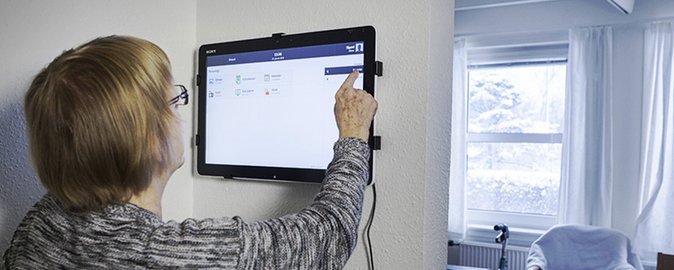- Education
-
Research
Current research
Talent
-
Collaboration
Businesses
Government agencies and institutions
Alumni
-
About AU
Organisation
Job at AU
Telemedicine goes perfectly with terms such as savings agenda and individualism. However, expectations that the technology itself solves all problems are grossly exaggerated, according to Finn Olesen. He is a technology philosopher who has personally been involved in a Danish telemedicine trial involving the ‘COPD suitcase’.
2014.02.14 |

Research and practical experience show that new technology always has unintended consequences, and we have to watch out for these in connection with telemedicine, says Associate Professor Finn Olesen. Photo: Maria Randima Sørensen.
“We easily forget to ask whether technological changes necessarily mean improvements, which can’t spread quickly enough,” says Associate Professor Finn Olesen, a technology philosopher at Aarhus University. “Research and practical experience show that new technology always has unintended consequences, and we have to watch out for these in connection with telemedicine,” he explains.
Gradual enthusiast
People like Associate Professor Olesen, who have reservations about the bliss of technology, can quickly be attributed with being both humanists and technophobes. Although he is happy to admit being a humanist, Associate Professor Olesen will not be called a technophobe under any circumstances.
“I call myself a ‘gradual enthusiast’. I endorse taking time to think very carefully about implementing new technology,” he says.
Associate Professor Olesen’s gradual enthusiasm was confirmed in connection with one of Denmark’s most highly profiled telemedical initiatives in recent years – the ‘COPD suitcase’ that was tested in the Funen hospitals.
The suitcase is basically a simple computer that enables nurses to treat COPD (chronic obstructive pulmonary disease) patients in their own homes. Associate Professor Olesen followed the online consultations from the nurse’s side in the hospital department, while a PhD student followed from the patient’s home. One of the most important observations was the number of potential sources of error associated with the technology, and how much it demands of both the nurse and the patient.
The monitor is deceiving
“There’s really a lot of information that doesn’t come out in this type of video consultation. At one point, I witnessed a consultation with a lovely elderly lady. She seemed to be functioning well and everything was in perfect order. I later observed a consultation where the first image on the monitor showed a man smoking and drinking beer in the background, and I thought there must be something completely wrong. But it was actually the reverse.”
“The first woman was lonely and not coping very well, while the other situation turned out to be a well-functioning woman living in a close-knit residential community. She sold a little beer on the side, and the man was one of her customers. The nurses were familiar with this because they had visited them at home as ‘oxygen nurses’ and knew them. It shows that telemedicine doesn’t just replace other forms of treatment,” says Associate Professor Olesen.
Nurse as interpreter
And there were many other examples of sources of error and possible misunderstandings while Associate Professor Olesen was observing the consultations. Was the lighting such that the nurse could actually see whether the patient’s lips were blue (a sign of insufficient oxygen)? Could the nurse see and instruct the patient in the use of particular instruments when only the patient’s torso was visible? And so on.
“Very competent nurses are required, and they must be extremely good at seeing through what the patient says. This is why countries like the Netherlands have specially trained staff,” says Associate Professor Olesen.
What do the patients think?
The technology changes the entire treatment situation for the patients. Do they like it, will they use it, and can they in fact use it at all?
“A number of patients said that the COPD suitcase was great, but they couldn’t really work out how to use it. Others were embarrassed by it and hid it in the laundry. Involving the patient is therefore extremely important regarding telemedicine, and their involvement must never come to an end during the implementation stage,” says Associate Professor Olesen.